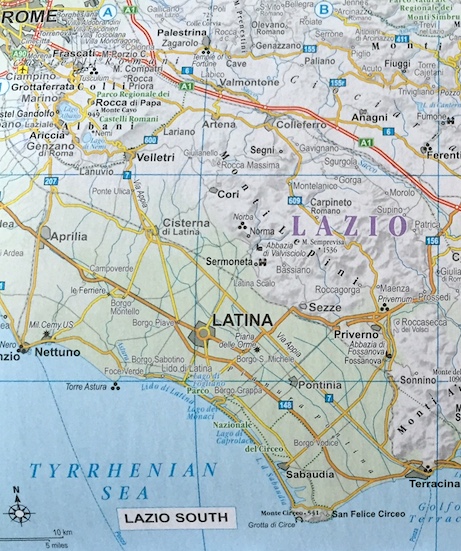It is always good to meet up with old students from the International Baccalaureate history classes I taught in the 1980s and even more special if they have followed a path that interests me. So it was a real pleasure to meet with Simone Quilici, an architect who now teaches the management of cultural heritage at the American University of Rome.

Simone has been working on landscaping projects in the Lazio region and he gave me the latest edition of Le Vie religiose nel Lazio, ‘the religious pathways of Lazio’, a map and guide to ancient pilgrimage routes that leave Rome. The most important routes are along the Via Francigena, the ancient pilgrim way recorded as early as the 8th century that can be traced from as far north as Canterbury. In a document of 990 recording the journey of Sigeric, the archbishop of Canterbury, to receive his pallium, the cloth that symbolised his office, from the pope, there is even a note of each stopping place. Sigeric averaged 20 kilometres a day and this is the average distance for each day’s walking that the map shows and describes for the first 200 kilometres of the Via outside Rome.
Although the word ‘Francigena’ recognises that this is a route from France, the map also shows a Francigena nel Sud, which branches out into two parts south of Rome, one heading down the Via Appia and the other crossing central Italy towards Monte Cassino. Added to these is a Cammino di Francesco that starts at the 14th-century Franciscan church on lake Piediluco, northeast of Rome and takes about 150 kilometres in seven daily stages to reach its destination, passing other Franciscan sites on the way. It seems to involve quite a lot of climbing although none of the routes is described as more than ‘of medium difficulty’.
It is clear from the helpful descriptions of each daily stage that although the walks do not always escape traffic, there is a feast of archaeological treats along the way: the ruins of cities, aqueducts, medieval villages and a host of churches. These are, after all, very ancient roads that recorded the earliest conquests of Rome as well as attracting settlements of all kinds, monastic and secular, in the centuries that followed. So the fourth day out along the Francigena del Sud, a long day with some climbing and panoramic views, takes in the medieval town of Norma (where the famous Ninfa gardens are to be found), the adjoining Roman site of Norba, the 14th-century abbey of Valvisciolo, associated with the Knights Templar, and the medieval centre of Sermoneta with its massive castle. The day finishes at Sezza, an ancient Volscan town, created a Roman colony as far back as 382 BC.
So these routes are much more than monotonous trudges dodging the traffic and the guide is an important initiative in publicising a region that tends to get neglected by visitors who stay only in Rome. It is much to be welcomed.
Le Vie religiose nel Lazio was published in 2014 by Touring Editore of Milan. At present there does not seem to be an edition in English but there deserves to be.
Reviewed by Charles Freeman. The places mentioned in this review are covered in detail in Blue Guide Central Italy. For more on Sigeric and his route to Rome, see Pilgrim’s Rome: A Blue Guide Travel Monograph.






